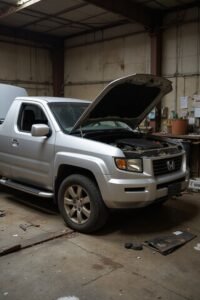You’ll want to steer clear of the 2007 Suburban due to its widespread 5.3L engine failures, 4L60E transmission issues, and faulty ABS systems. The 2001-2005 models suffer from transmission solenoid malfunctions and chronic oil leaks, while 2015-2016 years exhibit brake control module failures and torque converter problems. Watch for excessive oil consumption across 2010-2013 models. Our detailed analysis breaks down these critical mechanical failures and their warning signs.
The Notorious 2007 Model Year: A Perfect Storm of Problems
While the Chevrolet Suburban has established itself as a reliable full-size SUV platform, the 2007 model year stands out as particularly problematic due to its convergence of mechanical, electrical, and structural issues. The 5.3L engine suffers from Active Fuel Management system failures and low oil pressure conditions, while the 4L60E transmission exhibits reliability concerns past 100,000 miles. Despite these concerns, some owners report the drivetrain remains functional even beyond 400,000 miles with proper maintenance. Like the reliability scores of later Mini Countryman models, newer Suburban versions show significant improvements. Much like Ford’s Edge models from 2007-2008, transmission failures commonly plague this generation of Suburban.
You’ll encounter significant brake failures centered around ABS pump malfunctions and compromised brake lines. The dashboard compounds these issues with widespread cracking and failing instrument clusters that hamper critical system monitoring. Interior components deteriorate rapidly, from malfunctioning climate controls to failing power door locks. When diagnosing a 2007 Suburban, pay particular attention to engine concerns like failing motor mounts and transmission clusters that require sourcing parts from other GM vehicles.
Critical Issues in 2001-2005 Suburban Models
Although the 2001-2005 Chevrolet Suburban models offer robust hauling capabilities, they’re plagued by several critical drivetrain and electrical failures that require careful diagnostic attention. You’ll need to watch for transmission failures, particularly electronic solenoid malfunctions and transfer case issues that cause unexpected neutral shifts. With repair costs around $2,500, transmission problems in these model years frequently lead to complete system failure. Monitor your vehicle for oil leaks around the rear main seal and crankshaft areas, as these commonly require extensive repairs. Similar to the EGR cooler issues found in early Ram EcoDiesel models, these problems can lead to significant repair expenses.
Electronic malfunctions affect power windows, mirrors, and dashboard warning systems, while brake issues stem from stretched parking brake cables and deteriorating drum brake components. Don’t overlook coolant clogs and overheating problems, which often manifest as poor cabin heating and gurgling sounds from the heater core. Regular diagnostic checks and preventive maintenance are essential to manage these model-specific vulnerabilities.
Safety and Performance Concerns in 2015-2016 Models
Despite their modern amenities, the 2015-2016 Chevrolet Suburban models exhibit serious safety and performance deficiencies you’ll need to monitor. Brake failures emerge frequently at 55,000-60,000 miles, with the Electronic Brake Control Module causing unintended braking and vehicle pulling. You’ll encounter transmission issues requiring complete rebuilds, often stemming from torque converter and clutch failures that can cost upwards of $4,000 to repair. Similar to the excessive oil consumption reported in certain Subaru models, these Suburban years suffer from increased engine oil usage that requires frequent top-offs. Like the steering fluid leaks common in 2010-2011 Traverse models, power steering issues plague these Suburban model years.
The safety profile is particularly concerning, with a subpar 3-star rollover rating from NHTSA. Structural integrity issues stem from inadequately welded front upper control arms, while airbag deployment failures pose additional risks. The 2015 model reported 512 NHTSA complaints regarding various mechanical and safety concerns. When diagnosing these models, pay special attention to wheel-speed sensors, as their malfunction affects both the braking system and driveline-protection functionality.
Major Mechanical Red Flags Across Problem Years
Since mechanical reliability varies markedly across Suburban generations, you’ll need to watch for specific model-year defects that indicate severe drivetrain issues. Check for excessive oil consumption in 2010-2013 Vortec 5300 engines, where engine overheating and lifter ticking often precede catastrophic failure. Watch for knock sensor faults and random misfires in 2001-2003 and 2007-2010 models, typically requiring intake manifold gasket replacement. The high safety scores in 2012-2014 models offer some consolation against mechanical concerns during those years.
Monitor transmission fluid leaks carefully in 2015-2016 models, particularly around oil cooler lines. The 2009 model year exhibits premature engine failures, while 2007-2008 units show both engine and transmission problems by 55,000-81,000 miles. If you detect piston-to-valve interference symptoms or persistent oil level drops, prepare for significant repairs or complete engine replacement. Similar to the Silverado’s issues, many Suburban models suffer from rusting brake lines that require extensive repairs. Much like Toyota’s 2006-2009 Tacoma models with severe frame rust, SUV owners should thoroughly inspect the undercarriage for corrosion damage.
Understanding Recall History and Reliability Ratings
Beyond mechanical defects, the Chevrolet Suburban’s recall history reveals a complex pattern of safety and reliability concerns across multiple generations. Your recall analysis should focus heavily on the 2000 model year, which experienced 11 campaigns affecting 100% of vehicles, and the 2015-2016 period showing elevated recall frequencies. Similar to the CVT transmission issues plaguing multiple Nissan Rogue years, reliability problems can persist across model generations. Critical system failures include electronic stability control malfunctions, transfer case electrical shorts, and suspension component defects. Recent reliability trends indicate a concerning pattern of engine manufacturing defects in 2021-2024 models, specifically involving connecting rods and crankshafts. Like the Cadillac Escalade’s exhaust overheating issues in 2015-2016 models, systemic problems can affect entire vehicle platforms. A September 2023 recall highlighted issues with rear control arm bolts that were improperly heat-treated, requiring complete replacement by dealers. You’ll need to scrutinize platform-wide recalls affecting GM’s entire SUV lineup, as these indicate systemic engineering challenges. Models with high recall counts typically demonstrate compromised reliability ratings, particularly when safety-critical systems require dealer intervention for reprogramming or component replacement.



